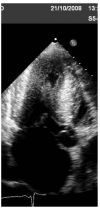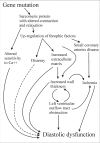Echocardiography in patients with hypertrophic cardiomyopathy: usefulness of old and new techniques in the diagnosis and pathophysiological assessment
- PMID: 20236538
- PMCID: PMC2848131
- DOI: 10.1186/1476-7120-8-7
Echocardiography in patients with hypertrophic cardiomyopathy: usefulness of old and new techniques in the diagnosis and pathophysiological assessment
Abstract
Hypertrophic cardiomyopathy (HCM) is one of the most common inherited cardiomyopathy. The identification of patients with HCM is sometimes still a challenge. Moreover, the pathophysiology of the disease is complex because of left ventricular hyper-contractile state, diastolic dysfunction, ischemia and obstruction which can be coexistent in the same patient. In this review, we discuss the current and emerging echocardiographic methodology that can help physicians in the correct diagnostic and pathophysiological assessment of patients with HCM.
Figures

















Similar articles
-
Echocardiography in hypertrophic cardiomyopathy: the role of conventional and emerging technologies.JACC Cardiovasc Imaging. 2008 Nov;1(6):787-800. doi: 10.1016/j.jcmg.2008.09.002. Epub 2008 Nov 18. JACC Cardiovasc Imaging. 2008. PMID: 19356516 Review.
-
Echocardiography in hypertrophic cardiomyopathy diagnosis, prognosis, and role in management.Eur J Echocardiogr. 2009 Dec;10(8):iii9-14. doi: 10.1093/ejechocard/jep157. Eur J Echocardiogr. 2009. PMID: 19889657 Review.
-
[Role of Doppler echocardiography in the diagnostics and therapy of hypertrophic cardiomyopathy].Cas Lek Cesk. 2006;145(4):279-83. Cas Lek Cesk. 2006. PMID: 16639927 Review. Czech.
-
Vector flow mapping in obstructive hypertrophic cardiomyopathy to assess the relationship of early systolic left ventricular flow and the mitral valve.J Am Coll Cardiol. 2014 Nov 11;64(19):1984-95. doi: 10.1016/j.jacc.2014.04.090. Epub 2014 Nov 3. J Am Coll Cardiol. 2014. PMID: 25440093
-
The role of echocardiography in hypertrophic cardiomyopathy.Curr Cardiol Rep. 2015 Feb;17(2):6. doi: 10.1007/s11886-014-0560-x. Curr Cardiol Rep. 2015. PMID: 25618305 Review.
Cited by
-
Myocardial Strain and Association With Clinical Outcomes in Danon Disease: A Model for Monitoring Progression of Genetic Cardiomyopathies.J Am Heart Assoc. 2021 Dec 7;10(23):e022544. doi: 10.1161/JAHA.121.022544. Epub 2021 Nov 30. J Am Heart Assoc. 2021. PMID: 34845930 Free PMC article.
-
Efficacy of echocardiography for differential diagnosis of left ventricular hypertrophy: special focus on speckle-tracking longitudinal strain.J Echocardiogr. 2021 Jun;19(2):71-79. doi: 10.1007/s12574-020-00508-3. Epub 2021 Jan 18. J Echocardiogr. 2021. PMID: 33460030 Free PMC article. Review.
-
Global longitudinal strain in pre-symptomatic patients with mutation for transthyretin amyloidosis.Orphanet J Rare Dis. 2024 Dec 5;19(1):458. doi: 10.1186/s13023-024-03473-7. Orphanet J Rare Dis. 2024. PMID: 39639351 Free PMC article.
-
A longitudinal study on BIO14.6 hamsters with dilated cardiomyopathy: micro-echocardiographic evaluation.Cardiovasc Ultrasound. 2011 Dec 8;9:39. doi: 10.1186/1476-7120-9-39. Cardiovasc Ultrasound. 2011. PMID: 22151912 Free PMC article.
-
Longitudinal strain bull's eye plot patterns in patients with cardiomyopathy and concentric left ventricular hypertrophy.Eur J Med Res. 2016 May 10;21(1):21. doi: 10.1186/s40001-016-0216-y. Eur J Med Res. 2016. PMID: 27165726 Free PMC article. Review.
References
-
- Maron BJ, McKenna WJ, Danielson GK, Kappenberger LJ, Kuhn HJ, Seidman CE, Shah PM, Spencer WH, Spirito P, Ten Cate FJ, Wigle ED. ACC/ESC clinical expert consensus document on hypertrophic cardiomyopathy: a report of the American College of Cardiology Task Force on Clinical Expert Consensus Documents and the European Society of Cardiology Committee for Practice Guidelines (Committee to Develop an Expert Consensus Document on Hypertrophic Cardiomyopathy) J Am Coll Cardiol. 2003;42:1687–713. doi: 10.1016/S0735-1097(03)00941-0. - DOI - PubMed
-
- Elliott P, Andersson B, Arbustini E, Bilinska Z, Cecchi F, Charron P, Dubourg O, Kühl U, Maisch B, McKenna WJ, Monserrat L, Pankuweit S, Rapezzi C, Seferovic P, Tavazzi L, Keren A. Classification of the cardiomyopathies: a position statement from the European Society Of Cardiology Working Group on Myocardial and Pericardial Diseases. Eur Heart J. 2008;29:270–6. doi: 10.1093/eurheartj/ehm342. - DOI - PubMed
-
- Doi YL, McKenna WJ, Oakley CM, Goodwin JF. 'Pseudo' systolic anterior motion in patients with hypertensive heart disease. Eur Heart J. 1983;4:838–45. - PubMed
-
- Pollick C, Rakowski H, Wigle ED. Muscular subaortic stenosis: the quantitative relationship between systolic anterior motion and the pressure gradient. Circulation. 1984;69:43–9. - PubMed
Publication types
MeSH terms
LinkOut - more resources
Full Text Sources

